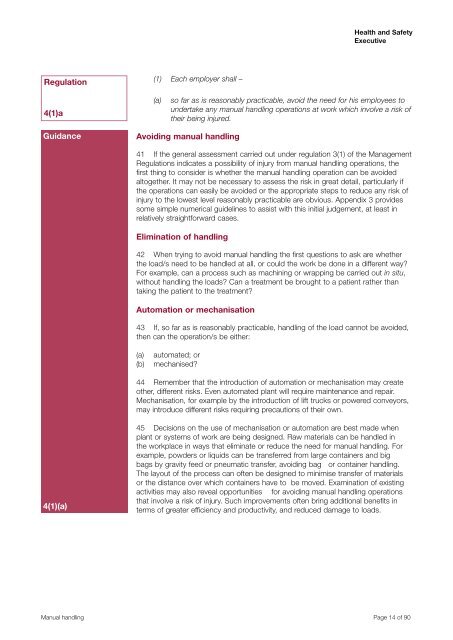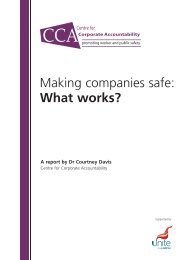Manual Handling Manual Handling Operations Regulations 1992 ...
Manual Handling Manual Handling Operations Regulations 1992 ...
Manual Handling Manual Handling Operations Regulations 1992 ...
Create successful ePaper yourself
Turn your PDF publications into a flip-book with our unique Google optimized e-Paper software.
Health and Safety<br />
Executive<br />
Regulation<br />
(1) Each employer shall –<br />
4(1)a<br />
(a)<br />
so far as is reasonably practicable, avoid the need for his employees to<br />
undertake any manual handling operations at work which involve a risk of<br />
their being injured.<br />
Guidance<br />
Avoiding manual handling<br />
41 If the general assessment carried out under regulation 3(1) of the Management<br />
<strong>Regulations</strong> indicates a possibility of injury from manual handling operations, the<br />
first thing to consider is whether the manual handling operation can be avoided<br />
altogether. It may not be necessary to assess the risk in great detail, particularly if<br />
the operations can easily be avoided or the appropriate steps to reduce any risk of<br />
injury to the lowest level reasonably practicable are obvious. Appendix 3 provides<br />
some simple numerical guidelines to assist with this initial judgement, at least in<br />
relatively straightforward cases.<br />
Elimination of handling<br />
42 When trying to avoid manual handling the first questions to ask are whether<br />
the load/s need to be handled at all, or could the work be done in a different way?<br />
For example, can a process such as machining or wrapping be carried out in situ,<br />
without handling the loads? Can a treatment be brought to a patient rather than<br />
taking the patient to the treatment?<br />
Automation or mechanisation<br />
43 If, so far as is reasonably practicable, handling of the load cannot be avoided,<br />
then can the operation/s be either:<br />
(a)<br />
(b)<br />
automated; or<br />
mechanised?<br />
44 Remember that the introduction of automation or mechanisation may create<br />
other, different risks. Even automated plant will require maintenance and repair.<br />
Mechanisation, for example by the introduction of lift trucks or powered conveyors,<br />
may introduce different risks requiring precautions of their own.<br />
4(1)(a)<br />
45 Decisions on the use of mechanisation or automation are best made when<br />
plant or systems of work are being designed. Raw materials can be handled in<br />
the workplace in ways that eliminate or reduce the need for manual handling. For<br />
example, powders or liquids can be transferred from large containers and big<br />
bags by gravity feed or pneumatic transfer, avoiding bag or container handling.<br />
The layout of the process can often be designed to minimise transfer of materials<br />
or the distance over which containers have to be moved. Examination of existing<br />
activities may also reveal opportunities for avoiding manual handling operations<br />
that involve a risk of injury. Such improvements often bring additional benefits in<br />
terms of greater efficiency and productivity, and reduced damage to loads.<br />
<strong>Manual</strong> handling Page 14 of 90
















